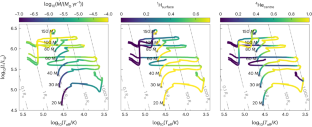2023-06-29 ノースウェスタン大学
◆この研究は、POSYDONソフトウェアを利用してブラックホールの合体を調査する最初のものです。また、この研究はブラックホールの形成メカニズムについての理論的な予測と観測データを調和させるために、新しいモデルを導入しました。この研究は重力波の発見以降、天体物理学者たちが宇宙の起源を理解するための探求を進める中で重要な進展です。
<関連情報>
- https://news.northwestern.edu/stories/2023/06/unveiling-the-origins-of-merging-black-holes-in-galaxies-like-our-own/
- https://www.nature.com/articles/s41550-023-02018-5
太陽系における質量30M⊙を超える合体ブラックホール形成の謎に迫る The formation of merging black holes with masses beyond 30 M⊙ at solar metallicity
Simone S. Bavera,Tassos Fragos,Emmanouil Zapartas,Jeff J. Andrews,Vicky Kalogera,Christopher P. L. Berry,Matthias Kruckow,Aaron Dotter,Konstantinos Kovlakas,Devina Misra,Kyle A. Rocha,Philipp M. Srivastava,Meng Sun & Zepei Xing
Nature Astronomy

Abstract
Gravitational-wave astronomy has revealed a population of stellar-mass black holes more massive than observed previously by other means. The maximum mass of black holes formed in isolated binaries is determined by stellar winds, mixing processes and interactions between the binary components. We consider the impact that fully self-consistent, detailed stellar-structure and binary-evolution calculations have on the population synthesis of black-hole binaries at solar metallicity. We find a qualitatively different picture from previous studies employing rapid population-synthesis techniques. Merging binary black holes form with a non-negligible rate (∼4×10−7 M⊙−1) and their progenitor stars with initial masses ≳50 M⊙ do not expand to supergiant radii, thereby largely avoiding substantial dust-driven or luminous blue variable winds. The progenitor stars lose less mass in winds, which results in black holes as massive as ~30 M⊙, and approximately half avoid a mass-transfer episode before forming the first-born black hole. Binaries with initial periods of a few days, some of which may undergo Roche-lobe overflow mass transfer, result in mildly spinning first-born black holes, χBH1 ≲ 0.2, assuming efficient angular-momentum transport.



